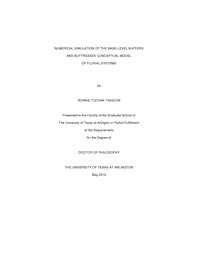| dc.description.abstract | A Buffer in fluvial stratigraphy is a potentiometric surface which defines either: a) the lowest possible depth to which streams will incise; or b) the maximum elevation to which aggradation will occur; together, these surfaces define a buffer zone. The buffer zone is tied down profile to a Buttress which defines base level for the system. A buttress shift, i.e., change in sea-level or shoreline-trajectory sensu (Catuneanu et al., 2009), will effect a change as to where the buffer zone exists for a fluvial system at a particular point in time. These terms were all introduced in (Holbrook et al., 2006) and these concepts were derived from outcrop investigations.Our work expounds upon these concepts by running a numerical model of landscape evolution, the Channel-Hillslope Integrated Landscape Development model (CHILD) (Tucker et al., 2001). Simulation of aggradation/degradation cycles using the CHILD Model shows that the buffer zone increases in range from a zero-thickness at the drainage divide, remains thin through provenance bed-rock streams, thickens through alluvial rivers to a maximum near the junction(s) of major tributaries and the primary trunk river, then thins downstream to one-channel thickness at the strand. Furthermore, we show that for periods of buttress stability and quiescent tectonics, buffer zones can attain thicknesses of over 150m due to climate variations, supporting local incision of valleys to comparable scale.This work has important implications on reservoir characterization and subsurface data interpretation, in that fluvial-valley geometries can be implied either laterally away from a bore-hole or on sub-seismic resolution 3D volumes. This also implies that deep valleys can be carved during falling and lowstand phases without significant buttress drop. | en_US |

